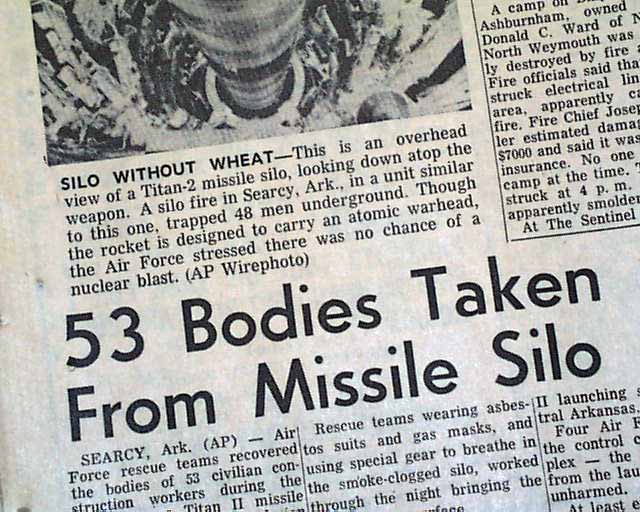
On this day in labor history, the year was 1965.
That was the day fifty-three construction tradesmen were killed in a fire at the Titan II ICBM launch complex near Searcy, Arkansas.
It is considered one of the worst industrial accidents at a U.S. nuclear weapons facility.
The complex was one of four sites containing Titan II missiles.
Each missile weighed 340,000 pounds, measuring 103 feet in length and 10 feet in diameter.
President Johnson had just committed more troops to the Vietnam War.
The Air Force hoped to strengthen the silo against a possible Soviet attack.
They had contracted with Peter Kiewit and Son of Colorado to bring in electricians, carpenters, millwrights, painters and pipefitters for a number of tasks.
Crews worked to shore up the silo, improve the blast doors, adjust hydraulics and install emergency lighting.
52 of 55 workers on all nine levels of the silo were almost immediately asphyxiated when it suddenly filled with smoke and heat.
The Air Force determined a welder on level 2 accidentally pierced a high-pressure hydraulic line, igniting the fire.
Investigators also concluded the silo lacked adequate ventilation, alternative exits and independent power sources.
The contractor was held responsible for numerous safety violations, contributing to unsafe working conditions.
The welder was found drowned in hydraulic fluid.
Two survivors suffered burns and smoke inhalation.
They contested the Air Force’s findings.
One worker insisted no one had been welding on level 2.
The other survivor stated he saw flames burst from the diesel engine just before the power went out.
Both men insisted the fire started from below.
By 1981, two more deadly accidents involving Titan II missiles would prompt President Reagan to order their deactivation.
More Episodes
 2024-09-10
2024-09-10
 2024-09-09
2024-09-09
 2024-09-07
2024-09-07
 2024-09-06
2024-09-06
 2024-09-06
2024-09-06
 2024-09-05
2024-09-05
 2024-08-30
2024-08-30
 2024-08-28
2024-08-28
 2024-08-27
2024-08-27
Create your
podcast in
minutes
- Full-featured podcast site
- Unlimited storage and bandwidth
- Comprehensive podcast stats
- Distribute to Apple Podcasts, Spotify, and more
- Make money with your podcast
It is Free
- Privacy Policy
- Cookie Policy
- Terms of Use
- Consent Preferences
- Copyright © 2015-2024 Podbean.com




